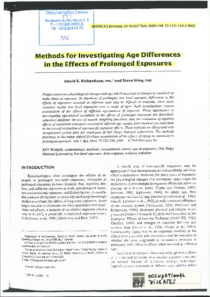Methods for investigating age differences in the effects of prolonged exposures

Wing, Steve ; Richardson, David
American Journal of Industrial Medicine
1998
33
2
123-130
age ; cohort study ; dose response relationship ; epidemiologic study ; exposure assessment ; ionising radiation ; laboratory work ; occupation disease relation
Occupational risks
English
Methods for evaluating age related differences in epidemiologic studies examining the effects of prolonged exposures were discussed. Subcohort analyses, use of weighting functions, and evaluating separate effects of cumulative exposure received at different age ranges (cross/classification analysis) were described. Subcohort analysis is usually done by distinguishing between individuals whose exposure histories begin at different ages or by using age at first exposure and age at last exposure in the analysis. Weighting functions can be used to discount exposures received before a certain age or to discount exposures not considered to be etiologically relevant. A variety of mathematical functions including step functions or linear, quadratic, or sigmoid weighting functions can be used for this purpose. Cross classification analysis can be used to separate the effects of cumulative exposure received at two different age ranges, thereby enabling trends in disease rates with increasing exposure received at one age period to be evaluated. The approaches were illustrated by application to a followup cohort study of the risk of cancer among employees at Oak Ridge National Laboratory (ORNL). The ORNL cohort consisted of 8,307 white males who had been hired between 1943 and 1972 and worked at the facility for at least 30 days. Subcohort analysis showed that an increase in cancer mortality occurred only in workers who received higher radiation exposures at ages of 45 years (yr) or greater. Workers in this age group showed an 8.55% increase in all cancer mortality per every 10 millisieverts (mSv) radiation exposure versus only a 3.02% increase in cancer mortality per 10mSv received before age 45yr. Cross classification analysis indicated that cumulative radiation doses received after age 45 were associated with a 5.46% increase in all cancer mortality per 10mSv exposure, whereas radiation doses received before age 45 were associated with only a 0.69% increase in cancer mortality per 10mSv. The weighting function approach also indicated that cancer mortality increased with age at exposure, the percentage increase per 10mSv varying from 2.28 to 6.49% depending on which particular function was used. The authors conclude that each method can contribute to the overall evaluation of age specific exposure effects in epidemiological studies.
Digital
The ETUI is co-funded by the European Union. Views and opinions expressed are however those of the author(s) only and do not necessarily reflect those of the European Union or the ETUI.